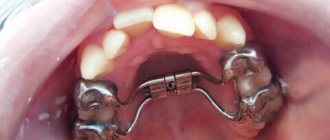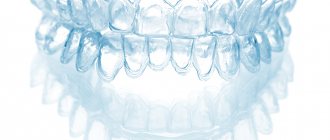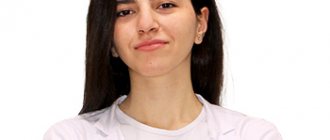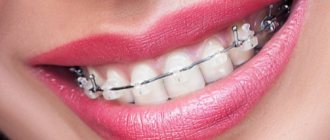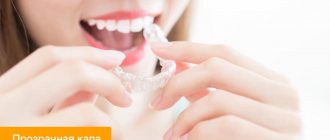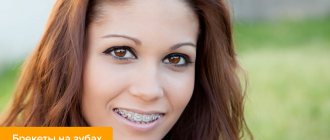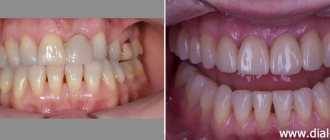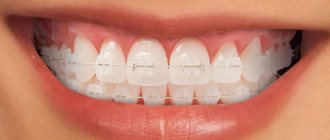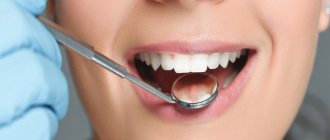Correcting the bite of an adult is a long and complex process, because you need to not only change the position of the teeth, but also correct disturbances in the usual functioning of the muscles, ligaments, spine and even the respiratory system. Therefore, the best results are achieved by an integrated approach, in which different specialists are involved in the treatment.
Correcting a bite is a complex treatment that requires a whole team of doctors
Dentist-therapist
This doctor is needed by almost everyone who is preparing to correct their bite. The fact is that a mandatory requirement before treatment is the elimination of all foci of caries, even superficial ones, and they are often impossible to notice on their own. It is also necessary to treat the common fissure caries (those that form in the recesses of the chewing teeth). After treatment, you need to carry out ultrasonic cleaning to remove tartar and Air Flow cleaning to completely remove soft plaque and polish your teeth. After such preparation, maintaining hygiene with braces or aligners will be easier.
Ways to correct bite in children
You can change the incorrect position of your teeth in several ways:
- Hardware - individually selected plates, trainers, braces, and aligners are used.
- Orthopedic – the child wears veneers, a face mask or mouth guards.
- Surgical - the defect is eliminated through surgery.
- Training of masticatory muscles or myogymnastics.
In some cases, complex treatment is prescribed, combining two, or less often three, methods of correcting the bite.
Conservative treatment
Most cases of malocclusion are corrected conservatively, and there are seven main methods for this.
A plate for correcting malocclusion in children is a device that changes the position of teeth. Advantages:
- a sufficiently strong effect on the jaw to effectively change the bite;
- fast production - the wait does not exceed a week;
- allow for complete oral hygiene during wearing.
- are cheaper than other devices;
- Suitable for correcting open bites in children.
Negative aspects of using a plate on children’s teeth to correct their bite. The device takes up a lot of space in the oral cavity, reducing the space for the tongue, so children often play with the plates - remove them, loosen them and loosen the fastenings. Another drawback is that this method of correction worsens diction, which is especially uncomfortable for schoolchildren. The third disadvantage is a partial disruption of taste perception, since some of the receptors are covered by a plate. Fourth, the device is effective in the early stages of the problem.
The next type of conservative treatment is mouthguards for correcting malocclusion in children, also known as elastopositioners or myofunctional trainers. Made of transparent silicone, the purpose of wearing the device is to train the muscles to subsequently hold the jaw in the correct position. The main age for wearing is children 5–12 years old. Pros of trainers:
- easy to take off and put on, which provides the possibility of complete oral care;
- do not interfere with taste perception and diction;
- there is no feeling that he is undergoing treatment;
- bioinert - allergies to the material are excluded.
There are also disadvantages to wearing mouth guards. This corrective product is suitable for a responsible and obedient child who will actually wear the device on his jaw and not in his pocket. The second disadvantage is that there is less force on the jaw, so it takes more time to correct the bite of children.
Another option for correcting malocclusion is functional devices consisting of metal and plastic parts. A distinctive feature is that they do not put pressure on the jaw, the force of action is directed to the masticatory muscles. Such devices are removed before eating and brushing teeth, so the sense of taste of food and oral hygiene are not affected, but the effect depends on the regularity and time of wearing. Most of the designs are quite bulky and take up a lot of space in the mouth.
The next option for correcting your bite is braces. The design is put on six teeth - four front incisors and two large molars. Peculiarities:
- High efficiency due to strong pressure on the jaw.
- The device is applicable only to permanent teeth, therefore it is suitable for children 6–7 years old and older.
- Constant wearing. On the one hand, this is a plus - the baby cannot remove the structure, but on the other hand, food particles get clogged under the parts of the device, and oral hygiene suffers.
- The need to limit the consumption of solid food, crushing it into small pieces.
For preschool children, braces are the fastest way to correct a malocclusion. The average wearing time is two years.
For teenagers, aligners are becoming a fashion trend - transparent, individually selected aligners made of inert material. Advantages of overbite correction without braces:
- The aligners are easily removable, so eating and brushing your teeth are natural and do not pose any problems;
- the edge of the mouthguard is treated, thanks to this it does not injure the mucous membrane of the gums and lips;
- almost invisible when worn;
- there is no impact of hard metal elements on the enamel;
- high efficiency;
- relatively short treatment time - the diastema is corrected, on average, in 5 months, bilateral alignment is carried out in 12–15 months.
An orthopedic way to correct a bite is to wear veneers, which are overlays on teeth made of ceramic, porcelain, and zirconium dioxide. They are worn only on permanent teeth, so the patient’s age cannot be less than 16 years. As a rule, they require the removal of tooth tissue - grinding it down, so they are not recommended for use on healthy teeth. Veneers can be installed for 2-3 years or worn for a lifetime, requiring periodic replacement. In the long term, they lead to wearing crowns.
A relatively rare type is a face mask for correcting malocclusion in children. It is a complex device with two points of emphasis - in the frontal and chin, and less often in the buccal areas. Most often used for crowded teeth and protruding lower jaw. The strong impact on the jaws allows you to wear a face mask only at home, not to wear it to school or outside, the total wearing time is from 10 to 16 hours every day.
Treatment methods
Hardware treatment is the most effective method of treatment, since wearing it does not require daily use.
Myogymnastics is a set of exercises aimed at correcting the bite and preventing its abnormal development. Each type of disorder has its own set of movements, so it is not recommended to choose it yourself - it is better to visit a dentist and consult.
Exercises to correct a child’s bite are used for the following disorders:
- open bite;
- underdevelopment of the orbicularis oris muscle;
- oblique bite;
- lower jaw pushed forward.
In addition, special classes are used after plastic surgery of the frenulum of the tongue to strengthen the tongue muscles.
The advantages of the myogymnast are that it is effective and does not require wearing apparatus. Disadvantages of the method - it is optimally suited for children aged 4 to 7 years, it requires parental control and understanding from the child, success depends on the regularity of performing the set of exercises.
Dentist-implantologist
Such a specialist is involved in treatment planning when there is a need for prosthetics.
If at the start of treatment some teeth are missing, then two tactics are considered.
- Tighten the spaces between teeth so that adjacent teeth replace the missing one. This is possible if, for example, the second molar (seven) was removed, but the third (eight, wisdom tooth) erupted. Functionally, these teeth differ little, so it is justified to move the figure eight to the place of the lost 7th tooth. But if we are talking about other teeth, then this treatment method can lead to asymmetry and an aesthetically unattractive result.
- Prepare the site for subsequent prosthetics. To do this, the teeth are not tightened, but rather, the space between them is expanded. During treatment with an orthodontist, you will have to spend some time with a noticeable gap in the row of teeth, and then contact an implantologist. This is a longer method of treatment, but the result is worth it: all the roots of the teeth will be in place, and an implant will be installed to replace the lost tooth.
This is what preparation for implantation looks like: with the help of braces, a place for the implant is prepared.
Sometimes the implantologist himself refers patients to the orthodontist. This happens if a patient applies for implantation, not knowing that malocclusion is an obstacle to prosthetics. In this case, the correct order of treatment is as follows: first correct the bite with orthodontic treatment, and only then install implants.
Basic information about gnathology
Gnathology is a branch of dentistry devoted to the work of the dentofacial apparatus and all its components - nerves, bones, chewing and facial muscles, periodontal tissues, joints, teeth. It is gnathology that is responsible for the correct structure of the jaw, normal chewing of food, and a beautiful smile.
Every dentist can have minimal knowledge and skills in this area, but when solving more complex and specific problems, you will definitely have to turn to a specialist - a professional gnathologist.
Orthopedic surgeon
An orthopedic surgeon deals with all problems of the musculoskeletal system.
If your posture is poor, the lower jaw shifts and it “pulls” the bite along with it.
All muscles and ligaments in the body work harmoniously. If bite asymmetry occurs, compensation inevitably occurs in the cervical or shoulder region, hence muscle strain and poor circulation. Almost all orthodontic patients have some degree of scoliosis or stooping. Although it is almost impossible to completely correct this problem in adults, it can be compensated for, thereby supporting treatment. Often, treatment aimed at relieving muscle spasms helps progress in correcting the bite, in addition, an integrated approach reduces the risk of relapses in the future, after treatment is completed.
An orthopedic surgeon can prescribe treatment that will help relieve muscle tension and eliminate tension in the shoulder, thoracic, and lumbar spine. This could be massages, physical therapy or physiotherapy.
What does a gnathologist treat?
Analyzing all existing health problems, a gnathologist determines cause-and-effect relationships between phenomena and offers optimal treatment for such diseases:
- TMJ dysfunction, articular disc displacement;
- pathological occlusion;
- bruxism or generalized abrasion.
The specialist can determine the interalveolar height (the distance between the bone ridges of the jaws), restore the correct guidance of the jaw from below and recreate the correct incisal and canine separation.
If the lower jaw constantly cramps, only a gnathologist can determine the causes of the unpleasant phenomenon and plan a course of treatment for the dental apparatus. The specialist will plan muscle relaxation therapy using splints and a disconnecting mouthguard.
Maxillofacial surgeon
This specialist is needed for those whose bite pathology requires surgery. Usually this is a pronounced mesial bite or a combination of several disorders, especially with a pathological narrowing of the jaw. The operation itself is only one of the stages of treatment; in preparation for it and after it, you still need to wear braces to stabilize the occlusion (closing of the teeth) and improve the aesthetics of the smile.
Surgical correction of the bite: the jaws are given the correct shape, but the teeth still need alignment
How does TMJ arthrosis manifest?
Osteoarthritis of the maxillofacial joint can be caused by trauma, inflammation, the absence of a large number of teeth, or the use of dentures with poorly formed dentition. The causes of the development of pathology can also be metabolic disorders, connective tissue diseases or nerve conduction disorders.
Symptoms of arthrosis appear gradually as dystrophic changes develop. Most often patients complain of:
- aching pain that can radiate to the upper part of the skull - the area of the eyes or ears;
- characteristic crunching or clicking sounds that occur when the joint moves;
- decreased mobility of the bone joint, especially noticeable in the morning;
- displacement of the lower jaw to the right or left side from the center.
Otolaryngologist
Cases where there is a direct connection between problems with the respiratory system and bite are not frequent, but sometimes a consultation with an ENT doctor is necessary. This is especially true for those who, before contacting an orthodontist, suffered from chronic ENT diseases with frequent exacerbations and impaired nasal breathing.
At the first appointment, the orthodontist collects information about the patient and asks about other diseases. A complete picture of your health condition will help you prescribe comprehensive treatment to achieve the best result and minimize the risk of regression.
Caring for installed devices
Removable and non-removable structures differ in care, but the basic principles are the same for any device:
- Daily cleaning. Removable appliances are removed and washed with a toothbrush or orthodontic brush under warm water. Toothpaste or soap is used as a cleanser. Fixed structures can be cleaned with a toothbrush during cleaning.
- An irrigator is used for effective cleansing.
- It is mandatory to rinse your mouth with warm water after every meal.
- Increased loads are excluded. You should not chew candies, nuts, crackers, cabbage stalks and other hard foods. It is important to remove candies with caramel, chewing gum, and toffees from your diet.
- Removable structures are stored in an individual container, which is washed weekly. Every two weeks, the devices are immersed in a disinfectant solution for eight hours, then thoroughly washed with running water.
- White and transparent structures can be stained by tea, coffee, boiled beets or carrots, which is also important to consider.

